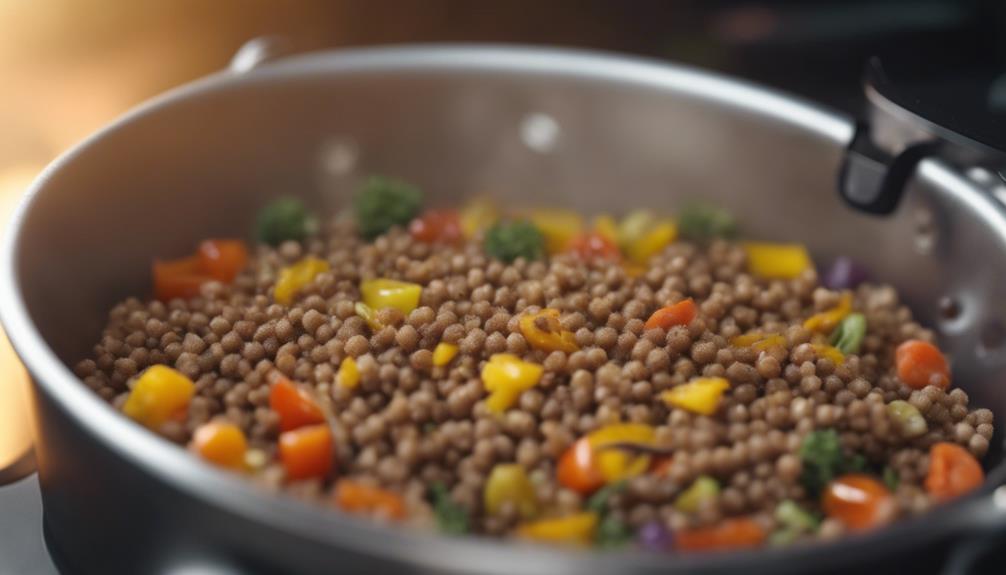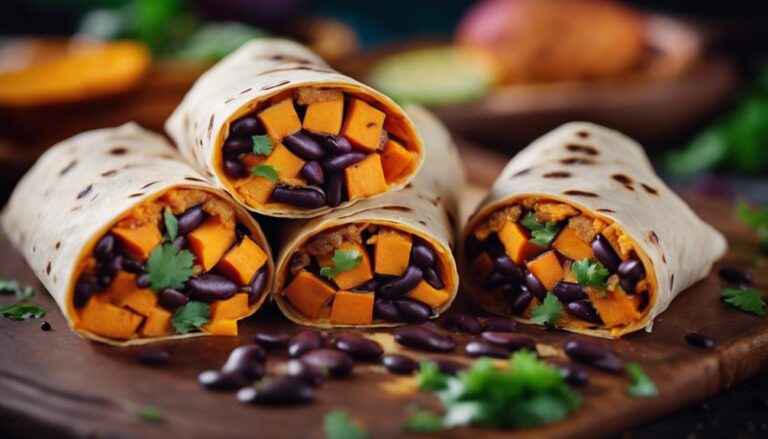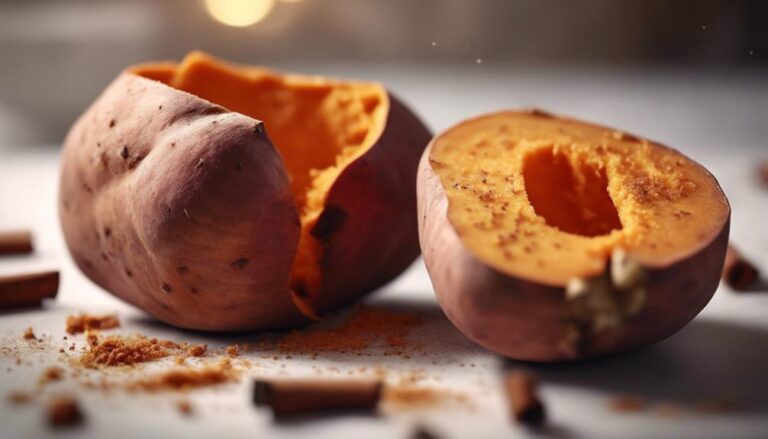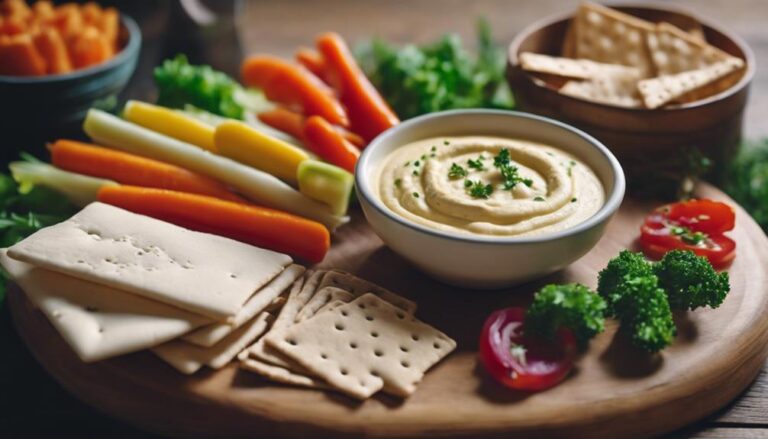Sous Vide Buckwheat and Vegetable Hash
For a flavorful Sous Vide Buckwheat and Vegetable Hash, begin with gluten-free buckwheat groats rich in fiber and protein. Season with herbs, spices, or umami ingredients. Sous vide cooking guarantees uniform cooking, enhancing the dish's texture. Personalize with a variety of vegetables for a nutritious meal. To further boost the flavors, experiment with different seasonings, oils, or natural sweeteners like honey. This versatile dish can serve as a main course or side, offering a unique culinary experience. Discover how sous vide enhances the flavors of buckwheat and vegetables in this wholesome hash.
What You Will Learn Here
- Sous vide ensures even cooking of buckwheat and vegetables.
- Buckwheat groats are gluten-free, rich in fiber and protein.
- Customize hash with a variety of seasonal vegetables.
- Use herbs, spices, and umami-rich ingredients for flavor.
- Serve as a versatile main or side dish.
Origin of Sous Vide
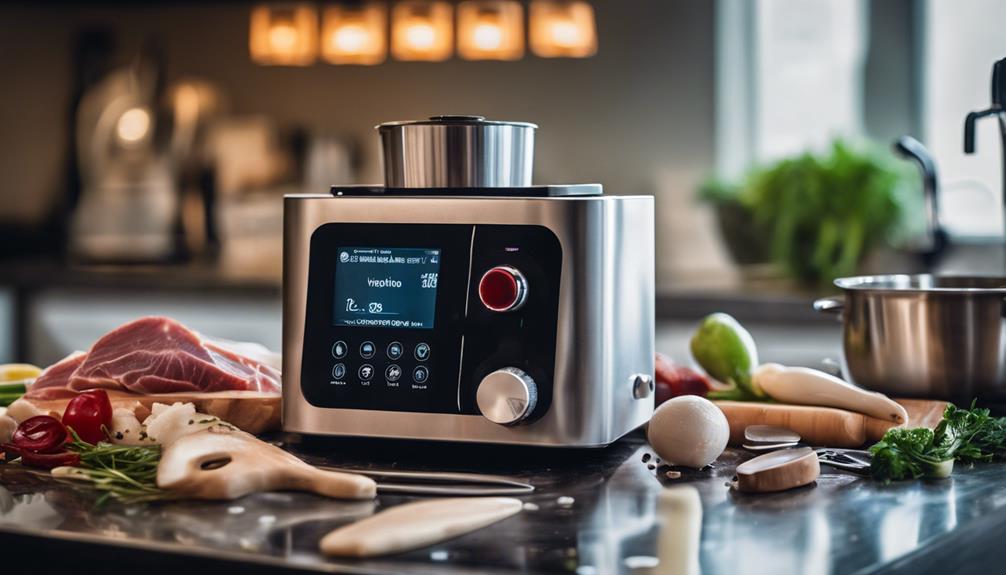
The origin of sous vide cooking can be traced back to French chefs in the 1970s, particularly Georges Pralus and Bruno Goussault. These chefs were instrumental in developing the techniques that define sous vide cooking today.
Sous vide, which means 'under vacuum' in French, revolutionized cooking by allowing precise temperature control and consistency in dishes.
Sous Vide Origins
Originating in France during the 1970s, the culinary technique of Sous Vide revolutionized the way food is cooked by utilizing precise temperature control within vacuum-sealed bags.
Chef Georges Pralus played a pivotal role in developing sous vide for culinary purposes. This method involves cooking ingredients in sealed bags at controlled temperatures, ensuring ideal flavor, texture, and consistency.
The term 'sous vide' translates to 'under vacuum' in French, highlighting the importance of vacuum-sealed bags in this cooking process. By maintaining exact temperatures throughout the cooking duration, sous vide allows for precise control over the final outcome of dishes, resulting in enhanced taste and mouthfeel.
This technique has since become a staple in professional kitchens and home cooking alike, offering a unique approach to preparing delicious meals.
Cooking Technique Evolution
Having laid the foundation with the origins of sous vide in the 1970s, let's explore the evolution of cooking techniques that led to the advent of this precise culinary method.
Chef Georges Pralus played a pivotal role in this evolution by pioneering the use of sous vide for consistent cooking results. This cooking technique involves vacuum-sealing food in bags and cooking it at precise temperatures, ensuring even cooking and ideal flavor retention in ingredients.
The evolution of sous vide has revolutionized cooking methods in professional kitchens, offering chefs the ability to achieve unparalleled control over the cooking process. This evolution marks a significant shift in culinary practices, emphasizing the importance of precision and technique in creating exceptional dishes.
Historical Sous Vide
In the 18th century, Benjamin Thompson, an American-born physicist, made a pivotal discovery regarding cooking food in a vacuum-sealed container. This discovery laid the foundation for what we now know as sous vide cooking.
Fast forward to the 1970s, French chef Georges Pralus further developed the technique by experimenting with vacuum-sealed cooking in low-temperature water baths. The term 'sous vide' translates to 'under vacuum' in French, emphasizing the importance of vacuum-sealing ingredients before cooking them at precise temperatures.
Over time, sous vide technology has advanced, with the introduction of immersion circulators and vacuum sealers, making this cooking method more accessible and popular among both home cooks and professional chefs. Sous vide enables precise control over cooking temperatures, resulting in consistently tender and flavorful dishes.
Buckwheat Groats
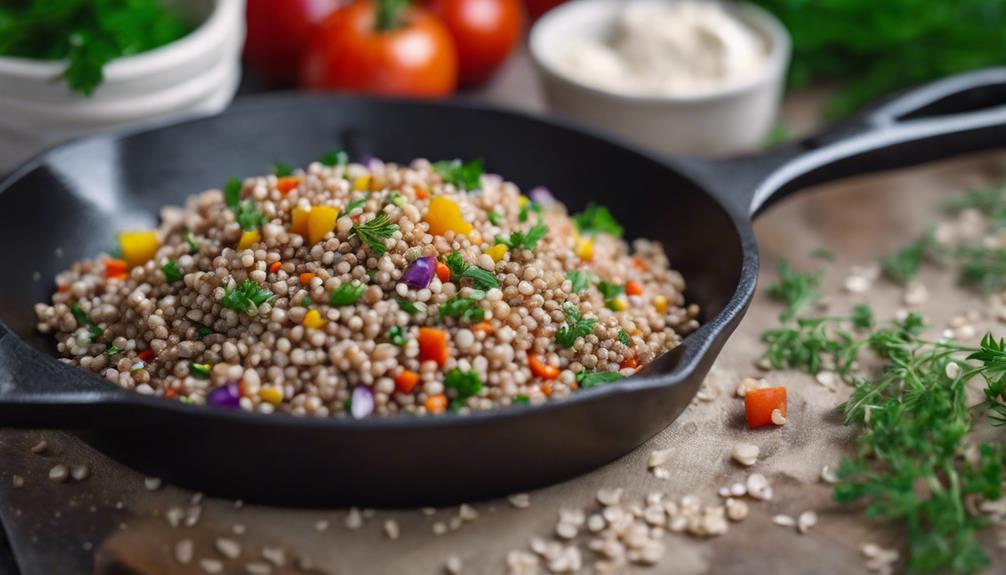
Buckwheat groats, rich in nutrients like fiber, protein, and antioxidants, are the hulled seeds of the buckwheat plant with a nutty flavor and chewy texture.
- When cooked sous vide, buckwheat groats maintain their shape and texture while absorbing the flavors from the cooking liquid.
- The gluten-free nature of buckwheat groats makes them a suitable option for individuals with gluten sensitivities or celiac disease.
- Their nutty flavor and chewy texture make buckwheat groats a versatile ingredient in various sweet and savory dishes.
- Sous vide cooking provides precise control over the doneness of buckwheat groats, ensuring they're perfectly cooked every time.
- The sous vide method allows for a hands-off approach to cooking buckwheat groats, freeing up time for other meal preparations.
Sous Vide Buckwheat Groats
When cooking sous vide buckwheat groats, consider enhancing their flavor by infusing them with herbs or spices.
Sous vide buckwheat groats can be transformed into a hearty and nutritious buckwheat porridge.
Experimenting with different flavor profiles can elevate the taste and versatility of your sous vide buckwheat groats dishes.
Buckwheat Groats With Herbs
Enhance the flavor profile of buckwheat groats by infusing them with a blend of aromatic herbs through the sous vide cooking method. When preparing sous vide buckwheat groats with herbs, consider the following:
- Utilize fresh herbs like rosemary, thyme, or parsley for a vibrant taste.
- Experiment with different herb combinations to find your favorite flavor profile.
- Make sure the herbs are finely chopped to evenly distribute the flavors.
- Seal the buckwheat groats and herbs in a vacuum-sealed bag to prevent flavor loss.
- Cook the mixture sous vide at a precise temperature to achieve a consistent texture and best infusion of herb seasonings.
Sous vide buckwheat groats with herbs offer a gluten-free, versatile base for a variety of delicious dishes.
Buckwheat Groats With Spices
Consider incorporating an array of aromatic spices to elevate the flavor profile of your sous vide buckwheat groats, enhancing their overall taste and richness.
- Cinnamon, nutmeg, and cloves can be added to enhance the flavor.
- Sous vide cooking maintains the natural nutty taste and chewy texture of buckwheat groats.
- Buckwheat groats are a versatile ingredient suitable for various dishes.
- The sous vide method guarantees a perfect texture and flavor.
- Buckwheat groats are a nutritious addition to meals, offering high protein, fiber, and essential nutrients.
Sous Vide Buckwheat Porridge
To prepare Sous Vide Buckwheat Porridge, maintain a precise cooking temperature of 185°F (85°C) for 20 minutes to achieve ideal texture and flavor retention.
Sous vide cooking locks in the nutrients of buckwheat, making it a healthy gluten-free option.
Buckwheat porridge pairs well with a variety of vegetables, herbs, and fruits for added flavor.
The sous vide water bath method guarantees consistent heat distribution, resulting in perfectly cooked buckwheat.
Experimenting with different seasonings and toppings allows for creative customization of the porridge.
This cooking technique preserves the natural flavors of buckwheat, enhancing the overall taste experience.
Sous Vide Buckwheat Seasoning
When seasoning buckwheat, it's important to contemplate ingredients like salt, pepper, and herbs such as thyme or rosemary to enhance its flavor.
Experiment with spices like cumin, paprika, or turmeric to further elevate the taste profile of the buckwheat.
Infusing the buckwheat with garlic, onion, or shallots can add a savory dimension to your dish.
Flavoring the Buckwheat
Enhance the flavor of your sous vide buckwheat by seasoning it with salt and pepper before cooking.
To further elevate the taste profile, consider infusing the buckwheat with herbs like thyme, rosemary, or sage.
For a savory twist, sprinkle some garlic powder or onion powder onto the buckwheat before cooking.
If you desire a umami-rich experience, a splash of soy sauce or tamari can do wonders.
To add a touch of heat, experiment with smoked paprika or cayenne pepper.
These flavoring options won't only complement the nutty undertones of buckwheat but also create a well-rounded and satisfying dish that's sure to please the palate of those you serve.
Seasoning Options
For a dynamic flavor profile in your sous vide buckwheat, consider incorporating a blend of herbs, spices, and umami-rich ingredients to elevate the dish to new heights.
Herbs like thyme, rosemary, and sage can add depth, while citrus zest such as lemon or orange provides a revitalizing twist.
Spices such as cinnamon, nutmeg, or cardamom bring warmth to the dish, enhancing the overall flavor profile.
Umami-rich ingredients like soy sauce, miso paste, or nutritional yeast can contribute savory notes that complement the buckwheat perfectly.
Experimenting with unique combinations of these seasonings allows you to create delicious sous vide buckwheat dishes that will delight your taste buds and impress your guests.
Tips for Enhancing
To elevate the flavor profile of your sous vide buckwheat, consider incorporating a blend of herbs, spices, and umami-rich ingredients for a more dynamic culinary experience. Seasoning with herbs like thyme, rosemary, or sage can add depth to the buckwheat. Enhance the dish further with aromatic spices such as cumin, paprika, or turmeric.
For a touch of sweetness, drizzle honey or maple syrup over the buckwheat hash. To introduce umami richness, include ingredients like soy sauce, miso paste, or nutritional yeast. Experiment with various oils like olive oil, sesame oil, or truffle oil to amplify the taste of the buckwheat hash.
Final Thoughts
When considering the overall experience of preparing and enjoying Sous Vide Buckwheat and Vegetable Hash, the harmonious blend of textures and flavors truly elevates this dish to a satisfying culinary delight. Buckwheat, a gluten-free grain rich in fiber and protein, not only adds a nutty flavor but also contributes to the heartiness of this dish. The sous vide cooking method guarantees that the buckwheat and vegetables are cooked evenly, resulting in ideal texture and flavor development.
One of the key advantages of vegetable hash is its customizability. By incorporating various vegetables such as bell peppers, onions, and zucchini, you can tailor the dish to suit your preferences or make use of seasonal produce. This adaptability makes vegetable hash a versatile option that can serve as a standalone main course or a flavorful side dish.
Frequently Asked Questions
Can You Sous Vide Mixed Vegetables?
You can sous vide mixed vegetables like carrots, potatoes, broccoli, cauliflower, zucchini, squash, peas, corn, bell peppers, onions, asparagus, mushrooms, beets, radishes, sweet potatoes, parsnips. Customize seasonings, vacuum-seal for nutrient retention, and cook evenly at 83°C for best texture.
What Is the Best Temperature for Sous Vide Vegetables?
For ideal tenderness and peak flavor, sous vide vegetables at 183°F (84°C). Accurate cooking yields consistent results, vibrant colors, and perfect doneness. Slow cooking retains nutrients, enhances taste, and balances flavors. Enjoy tender crunch, intense aromas, and natural sweetness.
Can You Cook Grains in Sous Vide?
Yes, you can cook grains in sous vide. Achieve ideal grain texture, flavor absorption, and nutrient retention with precise cooking times. Utilize sous vide technique for consistent results, explore seasoning options, recipe variations, and enjoy the health benefits of this method.
Is It Worth It to Sous Vide Vegetables?
Sous vide offers numerous benefits: enhanced tenderness, infused flavors, time savings, and precise texture control. It surpasses traditional methods by retaining nutrients, ensuring convenience, and elevating the overall vegetable experience. It's definitely worth it!
Conclusion
Overall, sous vide buckwheat and vegetable hash is a unique and delicious dish that showcases the versatility of sous vide cooking.
The exact temperature control guarantees the buckwheat groats are perfectly cooked, resulting in a satisfying texture.
The combination of vegetables adds a burst of flavor, making this dish a wholesome and nutritious option for any meal.
Try this recipe to experience the wonders of sous vide cooking in a new and exciting way.
